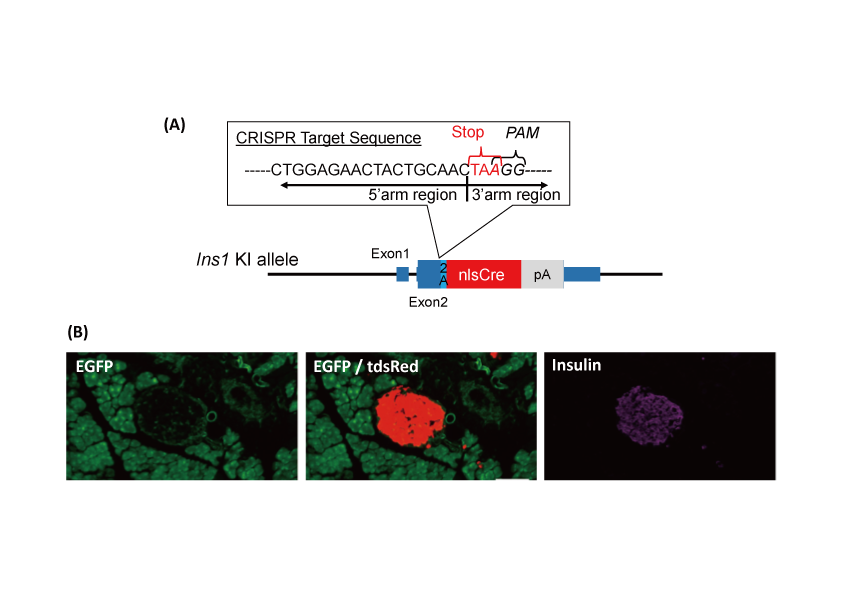 |
December 2018 Mouse of the Month |
|
Bicistronic Insulin1-Cre knock-in mice C57BL/6J-Ins1<em1(cre)Utr> (RBRC09525)Reproduced with permission of Japanese Association for Laboratory Animal Science from Yoshikazu Hasegawa, et al., 2016. Generation of CRISPR/Cas9-mediated bicistronic knock-in ins1-cre driver mice. Exp. Anim. 65(3): 319–327. (A) Strategy of bicistronic cre expression in I2AC mice |
|
Diabetes mellitus is a metabolic disorder due to impaired insulin action. Diabetic pathogenic mechanism is related to genetic factors. Therefore, in vivo experiments with genetically modified mice is important. Especially, the control of gene expression specifically in pancreas is effective. I2AC (Insulin1-2A–Cre recombinase) KI mice is a novel Cre-driver strain [2]. This strain enables the conditional gene expression in the pancreas by Cre/loxP system. The character of I2AC mice is mainly two as compared to conventional Insulin Cre-driver mice. One is that Cre recombinase expression is regulated by endogenous Insulin1 promoter, not Insulin2. This fact allows the restricted Cre recombinase expression only in pancreatic beta cells. The other is that 2A self-cleaving peptide is inserted prior to Cre recombinase gene. This fact allows the bicistronic expression without interruption of endogenous Insulin1 expression. Actually, I2AC mice showed no significant differences in results of glucose tolerance tests. Thus, I2AC mice will provide a new insight into glucose metabolic study. |
| Depositor | : | Fumihiro Sugiyama, Ph.D. Laboratory Animal Resource Center University of Tsukuba |
|
| Strain name | : | C57BL/6J-Ins1<em1(cre)Utr> | |
| RBRC No. | : | RBRC09525 | |
| References | : | [1] | Hasegawa Y, Daitoku Y, Sekiguchi K, Tanimoto Y, Mizuno-Iijima S, Mizuno S, Kajiwara N, Ema M, Miwa Y, Mekada K, Yoshiki A, Takahashi S, Sugiyama F, Yagami K. Novel ROSA26 Cre-reporter knock-in C57BL/6N mice exhibiting green emission before and red emission after Cre-mediated recombination. Exp Anim.; 62(4): 295-304, 2013. |
| [2] | Hasegawa Y, Hoshino Y, Ibrahim AE, Kato K, Daitoku Y, Tanimoto Y, Ikeda Y, Oishi H, Takahashi S, Yoshiki A, Yagami K, Iseki H, Mizuno S, Sugiyama F. Generation of CRISPR/Cas9-mediated bicistronic knock-in ins1-cre driver mice. Exp Anim.; 65(3): 319-327, 2016. | ||
| December 2018 Contact: Saori Mizuno, Ph.D. Experimental Animal Division, RIKEN BioResource Research Center All materials contained on this site may not be reproduced, distributed, displayed, published or broadcast without the prior permission of the owner of that content. |





